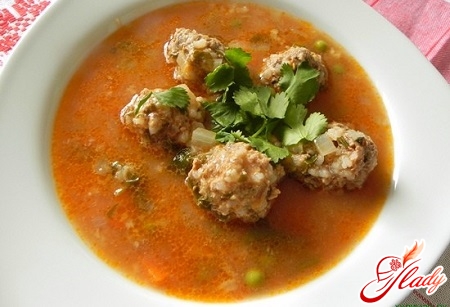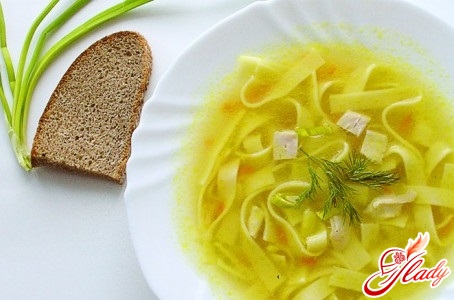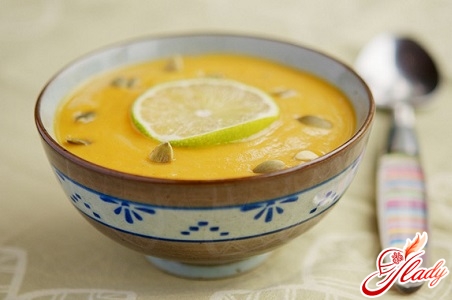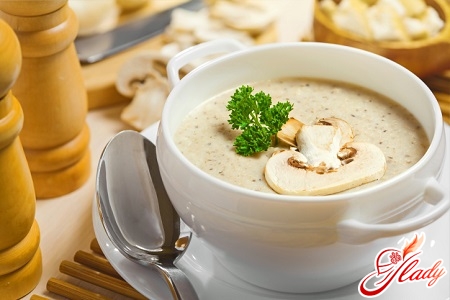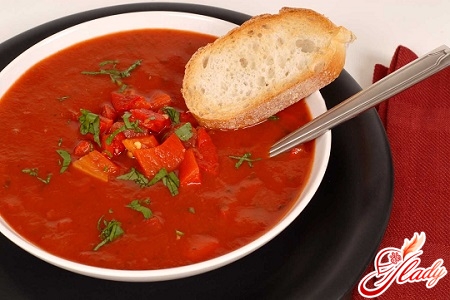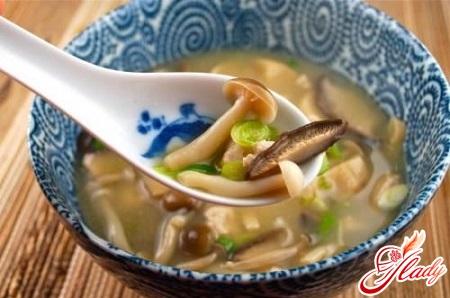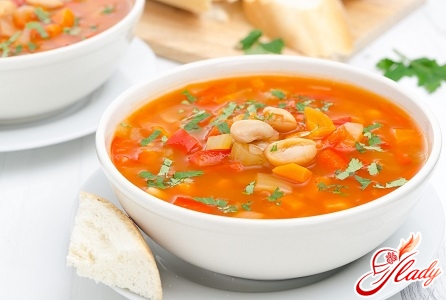
Wherever the conversation about Ukrainian cuisine begana kind word will necessarily be remembered Ukrainian borscht - a widely known, universally favorite dish. How did he get to our table and how to cook it correctly? Let's figure it out.
Historical Reflections and Searches
When people first decided to cook borschit is unknown to anyone. It is clear that the Slavs could have prepared it. Maybe a little different than what is being done now, but almost everything was for this. About the cabbage and beets, the ancient Greeks also wrote, and for the inhabitants of Kievan Rus the existence of these vegetables was not a secret. Did not know in those days of our ancestors of the existence of such overseas wonders, like potatoes, carrots and tomatoes. But our ancestors could cook borsch with turnip roots and deer bacon. It is also known that in the 9th century there was an edible plant in Russia, and who knows, everything could have started from him. But the name Ukrainian, Russian and Belarusian appeared much later, when the Rusich were no longer a single people. In the 13th-14th centuries a carrot arrived from Ukraine in Europe - a native of Afghanistan and supplemented the recipe, now, of Ukrainian borsch. In the first half of the XIX century, the collection of vegetables ended with the arrival of tomatoes and potatoes. They came from America and were received not gently, but eventually they settled down and settled forever. It can be safely asserted that in the second half of the nineteenth century, all the prerequisites for the establishment on our table of a real Ukrainian borsch in all its diversity were formed. 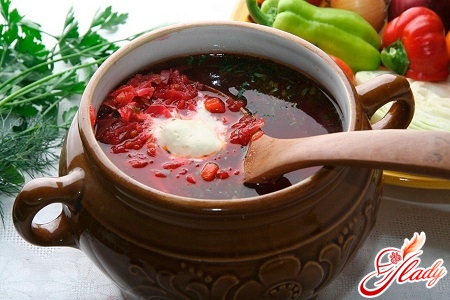
And how many borsch
Indeed, the varieties of this disha great many, but the exact number of names is not difficult - there are exactly as many as the hosts and culinary specialists - each has his own individual recipe. However, in different places people have their own taste preferences, and the borsch has become known as Chernigov, Odessa, Kiev, Volhynia, Poltava and others, by the name of the place of residence. Their main difference is the recipe for broth, for example, for Odessa borsch it should be goose, and for Poltava chicken. Despite a great variety of cooking methods, and taste preferences, there are quite strict rules, following which you can prepare a real Ukrainian delicious borsch.
How to cook broth
The most common broth for Ukrainianborsch - bone and meat-bone. Brain bones for the preparation of bone stock should be broken with a hammer, put in water and put on a strong fire. When the water boils, change the water, bring it back to a boil, add a little salt and continue cooking on low heat for hours 4-5. If it is meat-bone broth, then for an hour and a half before the end of cooking put portions of meat and for half an hour slices of bacon . The classic Ukrainian recipe assumes the obligatory presence of bacon. This is a feature of this borscht. Therefore, when the brewing is finished, the broth should be filtered, and the brewed bacon rubbed with garlic. For meat broth, the meat is washed, cleaned of film and veins, cut into portions, poured into water, brought to a boil, salt and for half an hour cooked over low heat. It is quite clear that the classic recipe assumes pork for the broth, but combining with other types of meat did not spoil the dish, but instead it worked for him. In some cases it is supposed to be cooked only on beef or mutton, and at the end of cooking add sausages or sausage, which brings the borscht to taste and recipe properties to the hodgepodge. 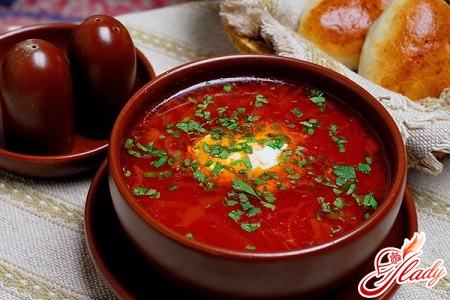
A few words about mushroom broth
It is impossible not to say about the mushroom broth. By age, he is one of the oldest, but still popular. With the advent of Christianity in Russia, mushrooms became the main component for soups, gravies, borscht and pies on fast days. A distinctive flavor is the white dried mushrooms. The recipe for making broth from them is not complicated, but time requires a lot. Dried mushrooms should be put in glass, ceramic or enameled dishes, pour boiling water, cover and leave to wet for 5-7 hours. Usually it is done in the evening, so that in the morning you can start cooking. The water in which the mushrooms are drained is poured, and the mushrooms themselves are cut into several parts or shredded with straws. After such preparation they are poured with water, brought to a boil and cook for 2-3 hours on low heat. Half an hour before the end of cooking, you can put a little dry bulbous husk. It, of course, will need to be removed as soon as the broth is cooked and infused. It is clear that in this case borsch must be prepared in vegetable oil. This is a lean recipe and the meat here will be clearly superfluous. While the broth is brewed it is possible to be engaged in vegetables. They are prepared in different ways and laid down for cooking at different times. This is a strict rule, otherwise not only the recipe will be broken, but it will not be possible to prepare a real borscht. 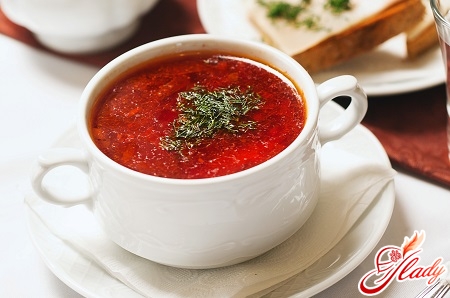
How to prepare vegetables
Onion and Bulgarian pepper shred, and carrots andThe root of parsley is rubbed on a large grater and passes all together in the melted lard or vegetable oil. When onions and carrots blush and get a golden hue, add finely chopped tomatoes or tomato mors and fry another 2-3 minutes. Until recently, morse from tomatoes in Ukraine harvested for future use everywhere. Now more often used tomato paste, but homemade fruit is still better. Cooking Morse, it was accepted a lot. In the second half of the summer, when tomatoes ripened, the housewives on trolleys and in bags carried them from the kitchen gardens or markets to the yards. There, under canopies, they cut whole tomatoes for whole days and cooked in huge saucepans on summer stoves. When the mors was ready, it was bottled, sealed with stoppers and poured into the necks with wax. In this form they were put down for storage in cellars or cellars. Beets are the most important ingredient. Without it, not only the recipe of Ukrainian, but also any other borsch is impossible. It is she who creates the appearance and the main taste of this popular and hotly loved dish. Red, rich, sweet, golden-amber, sour-it's all borsch, and makes it so beet. For bright red, sweet it is better to bake in the oven, and then cook in broth. For amber - the beetroot is cut with straws, a little is allowed in melted fat or vegetable oil, and then boiled in broth. Today, it is extremely rare to meet Ukrainian borsch, cooked with the addition of kvass. But until the middle of the last century it was a common practice. Kvass was cooked on beets. The recipe for cooking is not difficult: put warm beetroot grated beets and put on 3-4 days in a warm place. The resulting sourish drink is added to the almost ready dish for 15 minutes before the end of cooking. In our time it is absolutely impossible to imagine a Ukrainian borsch without potatoes and cabbage. These products are laid in a pan without preliminary heat treatment, however, they still need to be cooked. Potatoes are cut into cubes, then put on a sieve, washed again and dried on a towel. Excess starch will wash away the water, and the broth from the potatoes will not foam. Cabbage must be cut with straw. So it was led, otherwise it would not be soup, but cabbage soup. It is cooked quickly and therefore it needs to be pawned for 15-20 minutes before the end of cooking.
What when and how much to cook
Thus, the cooking recipe will havethe following time schedule: 4 hours brew the bone broth, then add the portioned meat, beets cut with straws and cook for another hour, strain, put again on the fire and put the potatoes sliced, cubes, cook for 15-20 minutes, and add the cabbage, after 15 -20 minutes add the fried carrots, onion, bell pepper and parsley, cook for 5 minutes, then put the laurel leaf, finely chopped greens and garlic, rubbed with bacon and cook for another 3-5 minutes, remove the pan from the fire, cover with a lid and let it brew not less than half an hour. It should be noted that this is a recipe for a golden amber borsch. To make it red, baked or lettuce on beet or oil, put beets for half an hour before laying the potatoes and then boil with all the vegetables together. For preparation it will be required:
- 300 g of porcine brain bones,
- 500 g of pork,
- 20 g of pure fat,
- 250 g of beet,
- 400 g of potatoes,
- 400 g of cabbage,
- 1 large onion,
- 1 Bulgarian pepper,
- 1 medium carrot,
- 1 small root of parsley,
- 1 fresh tomato (200 g of mors or 3 tablespoons of tomato paste),
- 2 cloves garlic,
- 2-3 bay leaves,
- Dill and parsley greens,
- Salt to taste.
It would seem that everyone: the recipe is met, the dish is ready, but in order to borsch was exactly Ukrainian, real, classic it must be served with pampushkas or potaptsami. If everything is clear with pampushkas - they occupy a worthy place on the dining table, then the potaps began to be undeservedly forgotten, but in vain. Prepare them very easily, here's the recipe: cut the fat into thin slices and fry in a frying pan until transparent. In a heated bacon, fry pieces of rye or wheat bread and put fried slices of fat on it. On top of such a sandwich you can sprinkle with herbs or put fried onion rings, or you can pound garlic. In any version, the potapets will be delicious, but with borshch and not reflect at all. And in conclusion, two more words. In Ukraine, traditionally at any time of the year, cooked on stoves - in the warm season on summer, under a canopy, and in winter in huts and also on the stove. So borsch, cooked on a stove is not as good as what was cooked on a gas stove. This gives him a special flavor.




